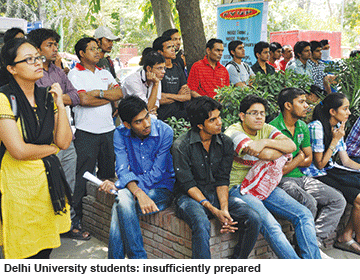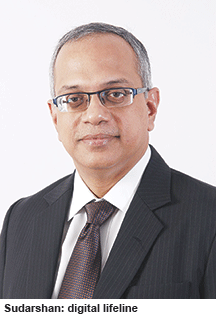Decontrol Higher Education
Although the country boasts 37,000 colleges and 735 universities, the fundamental problem of post-independence India’s higher education system is excessive Central and state government control
UNSURPRISINGLY ALL THE accumulated sins of omission and commission of the past six decades in preschool, primary and secondary education have risen to an ugly froth in India’s higher education system. Although the country boasts 37,000 undergraduate colleges and 735 universities with some of them established over 150 years ago, not even one is ranked among the Top 200 in the World University Rankings league tables published annually by the highly-respected London-based rating agency Quacquarelli Symonds, Times Higher Education (THE) or even of the Shanghai Jiao Tong University.
 India’s top-ranked institution of higher education in THE World University Rankings 2013-14 is a surprise Panjab University ranked #226-250.
India’s top-ranked institution of higher education in THE World University Rankings 2013-14 is a surprise Panjab University ranked #226-250.
For a nation long accustomed to supinely accepting Western superiority in industry, agriculture, manufacturing, education and health, the rock-bottom ranking of Indian varsities would not rankle as much if several Asian universities in China and South Korea were not ranked among the Top 100, despite India boasting a substantially larger number of universities and institutions of higher education in 1947.
Injured pride and sentiment aside, the damaging outcome of accumulated neglect and abuse of preschool-12 education is that a substantial majority of the country’s graduates are insufficiently prepared for the world of work. According to a devastating McKinsey World Institute-NASSCOM study (2005), 75 percent of India’s 350,000 engineering graduates and 85 percent of arts, science and commerce graduates are unfit for employment in multinational companies which insist upon minimum standards.
A more recent report by Aspiring Minds, a Gurgaon-based recruitment company that assessed the employability of over 60,000 bachelor’s degree holders countrywide, and published an Employability Report on Indian Graduates (2013), 47 percent of arts, science and commerce graduates certified by Indian universities are unemployable.
“For an analyst’s role, close to 84 percent graduates were found to lack the right levels of cognitive ability. 90 percent of graduates did not have the required proficiency in English communication. The employability of graduates varies from 2.59 percent in functional roles such as accounting to 15.88 percent in sales-related roles and 21.37 percent for roles in the business process outsourcing sector. A significant proportion of graduates, nearly 47 percent, were found not employable in any sector, given their insufficient English language and cognitive skills,” says the report in a damning indictment of collegiate education in India.
The fundamental problem of post-independence India’s higher education system is excessive Central and state government control. All the country’s 735 universities are subject to the supervisory jurisdiction of the Delhi-based University Grants Commission (UGC, estb. 1956) which was established to heavily subsidise and supervise the operations of the country’s 42 Central government varsities.
But over a period of time, UGC has extended its jurisdiction to accredit and approve all institutions, and academic programmes offered by the country’s arts, science and commerce colleges. Likewise, the study programmes of 7,500 engineering colleges and 4,300 B-schools among other technical education institutes (pharma, business and hotel management etc) until recently had to be approved by the Delhi-based All India Council for Technical Education (AICTE, estb. 1987).
Under this complex and slothful structure — the process of the over-burdened UGC and AICTE approving every new course takes ages — the syllabi of India’s higher education institutions have become obsolete, leading to poor and industry mismatched learning outcomes. This command and control mania has also constricted the supply of professional education countrywide.
With the Central and all state governments running large budget deficits unable to promote professional education colleges in sufficient numbers because they become unviable ab initio due to mandatory subsidisation of tuition fees, private education providers including philanthropists and for-profit education entrepreneurs have stepped up to meet unfulfilled demand. But India’s infamous licence-permit-quota regimen pervasive across the education spectrum has enabled a large number of unscrupulous state-level politicians and profiteers with inside information of the complex institutional licencing process to establish engineering and medical colleges, whose short-cuts and scams have given private professional education as a whole, a bad reputation. In turn, this has prompted more intensive control and regulation of private professional colleges even though some of them have been conferred deemed university status by UGC.
Moreover, capacity expansion in urgently needed professional education has been restricted by the state governments which appropriate large quotas even in financially independent (unaided) professional education colleges for students passing their common entrance tests (CET), who are forced upon colleges at rock bottom tuition fees. Unfortunately, this ‘backdoor nationalisation’ of private professional colleges was approved by a succession of judges of the Supreme Court which was packed by the late prime minister Indira Gandhi with justices subscribing to the confused Nehruvian neta-babu socialism. The result is even private professional colleges are financially strained and bedevilled by numerous scams and scandals.
Yet despite the supreme court acknowledging the error of its ways and freeing private professional colleges from their historical obligation to surrender 40-50 percent of their seats to government ‘merit’ students through landmark verdicts in the T.M.A Pai Foundation (2002) and Inamdar’s Case (2005), state governments, especially in the south, continue to arm-twist and bully private college managements to surrender large quotas for CET students paying below cost-of-provision tuition fees. Little wonder the best and most respected private providers of professional education such as the Manipal Engineering and Medical Group and Amity University are expanding faster overseas where they are given red carpet welcomes, rather than red-tape bedevilled India.
“It’s indisputable that the state of the professional and higher education system is less than satisfactory. Although during the past decade there’s been a lot of hype about higher education reforms, nothing much has really happened,” says Anand Sudarshan, hitherto chief executive (2006-12) of Manipal Global Education Services who is widely credited for taking the Manipal Group digital and international, and is currently promoter-CEO of the Bangalore-based Sylvant Advisors Pvt. Ltd.
According to Sudarshan, the new NDA government in Delhi needs to kick-start three substantive initiatives to get the process of revitalisation and reform of higher education going — revision of the National Policy on Education (NPE) last revised in 1992 “before the IT and telecom revolutions” and the “core document that guides national policy-making in education”; abolition of licence-permit-raj from education and “unshackling” private and foreign educationists to build capacity, and thorough overhaul of the higher education sector to make it innovations and outcomes-oriented.
“In particular, the Modi government and the Union HRD ministry need to encourage and facilitate the use of new technologies in higher education. Over a period of time, this will not only improve gross enrolment ratios, but it will also reduce costs of education delivery and subsidies. Moreover, incremental utilisation of new technologies will align the education system to young Indians who are rapidly transforming into digital natives,” says Sudarshan.
Quite clearly, decades of neglect and abuse of post-independence India’s preschool-12 education system have come to a boil in the country’s beleaguered institutions of higher education bedevilled by excessive controls and over-regulation. The immediate need is to loosen the establishment’s grip and restore the country’s 735 universities their academic freedom while transforming the best among them into autonomous varsities.
Moreover the administrative system under which often 500-700 colleges are affiliated with a parent university also needs to be dismantled, with reputed colleges conferred autonomous university status. Meanwhile indigenous private and foreign universities keen to promote greenfield projects and plant their flags in India need to be encouraged and facilitated.
Increased competition is the condition precedent of institutional upgradation and the qualitative push urgently required in India’s crumbling higher education sector.
Also read: NEP 2020: Higher Education | Institutional Restructuring and Consolidation















Add comment